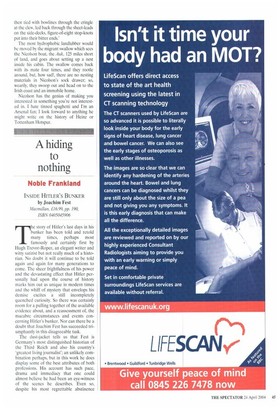A hiding to nothing
Noble Frankland
INSIDE HITLER'S BUNKER by Joachim Fest Macmillan, £16.99, pp. 190, ISBN 0405045906 The story of Hitler's last days in his bunker has been told and retold many times, perhaps most famously and certainly first by Hugh Trevor-Roper, an elegant writer and witty satirist but not really much of a historian. No doubt it will continue to be told again and again for many generations to come. The sheer frightfulness of his power and the devastating effect that Hitler personally had upon the course of history marks him out as unique in modern times and the whiff of mystery that envelops his demise excites a still incompletely quenched curiosity. So there was certainly room for a pulling together of the available evidence about, and a reassessment of, the macabre circumstances and events concerning Hitler's bunker. Nor can there. be a doubt that Joachim Fest has succeeded triumphantly in this disagreeable task.
The dust-jacket tells us that Fest is Germany's most distinguished historian of the Third Reich and also his country's 'greatest living journalist'; an unlikely combination perhaps, but in this work he does display some of the best attributes of both professions. His account has such pace, drama and immediacy that one could almost believe he had been an eye-witness of the scenes he describes. Even so, despite his most regrettable abstinence from footnotes, he has, at least to a great extent, subjected himself to the control of historical rules.
Fest sees the bunker as the epitome of Hitler's regime, for he believes that his entire inspiration and endeavour was destructive. He did not seize power to reform; he seized it to make war. He did not make war to subjugate nations; he did it to destroy them. Ultimately he did not resist to save the German people; he did it to immolate them. The bunker, where at last he destroyed himself, symbolised the whole thing.
So we are left at the end of this incomparable German catastrophe without even a flicker of sympathy for the man who once ruled half of Russia and most of Europe and was finally reduced to a shabby underground existence, moving armies that did not exist from here to there, ordering officers to be shot one day and promoting them to high command the next, and marrying, but not sleeping with, Eva Braun. All we are left with is the enduring question of how could the German people have sustained Hitler in power for so long.
The awful pall of doom and gloom that necessarily hangs over this whole ghastly story occasionally lifts for a brief moment such as, for example, when we are told the Russians made a special captive of a German private soldier and carted him off to Moscow for extra interrogation. He turned out to be the proprietor of a cigar store in Potsdam, but his name was Trumann. There are also some odd twists. Among those who resisted the Russians in Berlin most tenaciously and to the very end were the French SS division Charlemagne, Dutch and Scandinavian SS units and the remnant of a Latvian corps. They after all did not have much of a homecoming to look forward to.
Sure it is that the book provides a starker and more meaningful warning against the horror and folly of war than the philosophical musings of pacifists such as Bertrand Russell. And photographs have much to say in ramming that warning home, for they can add impressions that elude the written word. Those included in this book are well and relevantly chosen and, most unusually. correctly located in the text. Unfortunately. however, they are so poorly and no doubt cheaply reproduced that much of their instructive impact is lost. Also unfortunately, the index is far from adequate. There is an interesting bibliography, though it seems odd that Speer's Inside the Third Reich is not included, especially as there are passages in Fest's account that are clearly based on that work. Despite being an inveterate liar. Speer does nevertheless provide valuable insights, such as Hitler's proclivity towards personal bunkers even in the early stages of the war, and, of course, his deep interest in architecture which showed one respect in which his motivation was not wholly destructive.



















































































 Previous page
Previous page